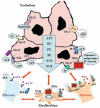Neural control of the lower urinary tract: peripheral and spinal mechanisms
- PMID: 20025024
- PMCID: PMC2910109
- DOI: 10.1002/nau.20837
Neural control of the lower urinary tract: peripheral and spinal mechanisms
Abstract
This review deals with individual components regulating the neural control of the urinary bladder. This article will focus on factors and processes involved in the two modes of operation of the bladder: storage and elimination. Topics included in this review include: (1) The urothelium and its roles in sensor and transducer functions including interactions with other cell types within the bladder wall ("sensory web"), (2) The location and properties of bladder afferents including factors involved in regulating afferent sensitization, (3) The neural control of the pelvic floor muscle and pharmacology of urethral and anal sphincters (focusing on monoamine pathways), (4) Efferent pathways to the urinary bladder, and (5) Abnormalities in bladder function including mechanisms underlying comorbid disorders associated with bladder pain syndrome and incontinence.
Figures

Similar articles
-
Beyond neurons: Involvement of urothelial and glial cells in bladder function.Neurourol Urodyn. 2010;29(1):88-96. doi: 10.1002/nau.20747. Neurourol Urodyn. 2010. PMID: 20025015 Free PMC article.
-
Can the adrenergic system be implicated in the pathophysiology of bladder pain syndrome/interstitial cystitis? A clinical and experimental study.Neurourol Urodyn. 2015 Jun;34(5):489-96. doi: 10.1002/nau.22542. Epub 2013 Dec 24. Neurourol Urodyn. 2015. PMID: 24375689 Free PMC article.
-
The afferent system and its role in lower urinary tract dysfunction.Curr Opin Urol. 2011 Jul;21(4):268-74. doi: 10.1097/MOU.0b013e3283476ea2. Curr Opin Urol. 2011. PMID: 21537194 Review.
-
Continence and micturition: an anatomical basis.Clin Anat. 2014 Nov;27(8):1275-83. doi: 10.1002/ca.22388. Epub 2014 Mar 10. Clin Anat. 2014. PMID: 24615792 Review.
-
Bladder afferent hyperexcitability in bladder pain syndrome/interstitial cystitis.Int J Urol. 2014 Apr;21 Suppl 1(0 1):18-25. doi: 10.1111/iju.12308. Int J Urol. 2014. PMID: 24807488 Free PMC article. Review.
Cited by
-
Neurogenic mechanisms in bladder and bowel ageing.Biogerontology. 2015 Apr;16(2):265-84. doi: 10.1007/s10522-015-9554-3. Epub 2015 Feb 11. Biogerontology. 2015. PMID: 25666896 Free PMC article. Review.
-
Experimental colitis triggers the release of substance P and calcitonin gene-related peptide in the urinary bladder via TRPV1 signaling pathways.Exp Neurol. 2010 Oct;225(2):262-73. doi: 10.1016/j.expneurol.2010.05.012. Epub 2010 May 23. Exp Neurol. 2010. PMID: 20501335 Free PMC article.
-
Spinal interneurons and micturition reflexes: focus on "Characterization of a spinal, urine storage reflex, inhibitory center and its regulation by 5-HT1A receptors in female cats".Am J Physiol Regul Integr Comp Physiol. 2010 May;298(5):R1195-7. doi: 10.1152/ajpregu.00127.2010. Epub 2010 Mar 3. Am J Physiol Regul Integr Comp Physiol. 2010. PMID: 20200134 Free PMC article. No abstract available.
-
Sexual Health Dysfunction After Radiotherapy for Gynecological Cancer: Role of Physical Rehabilitation Including Pelvic Floor Muscle Training.Front Med (Lausanne). 2022 Feb 3;8:813352. doi: 10.3389/fmed.2021.813352. eCollection 2021. Front Med (Lausanne). 2022. PMID: 35186978 Free PMC article. Review.
-
Challenges in the pharmacotherapy of urogenital disorders.Front Pharmacol. 2010 Sep 16;1:117. doi: 10.3389/fphar.2010.00117. eCollection 2010. Front Pharmacol. 2010. PMID: 21811458 Free PMC article. No abstract available.
References
-
- Apodaca G. The uroepithelium: Not just a passive barrier. Traffic. 2004;5:117–28. - PubMed
-
- Lewis SA. Everything you wanted to know about the bladder epithelium but were afraid to ask. Am J Physiol. 2000;278:F867–74. - PubMed
-
- Hicks M. The mammalian urinary bladder: An accomodating organ. Biol Rev. 1975;50:215–46. - PubMed
-
- Sun TT. Altered phenotype of cultured urothelial and other stratified epithelial cells: Implications for wound healing. Am J Physiol. 2006;291:F9–21. - PubMed
Publication types
MeSH terms
Substances
Grants and funding
LinkOut - more resources
Full Text Sources
Other Literature Sources
Medical

